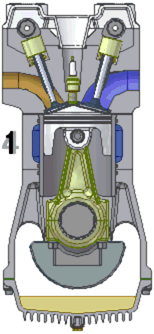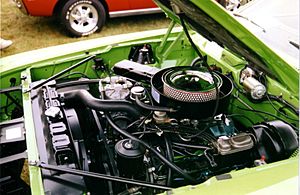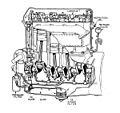Internal combustion engine facts for kids
An internal combustion engine is a special kind of engine where combustion (which means burning fuel) happens inside the engine itself. Think of it like a tiny, controlled explosion happening over and over again inside a sealed box called a cylinder. This explosion creates a lot of pressure.
This pressure pushes a part called a rod, which is connected to a wheel. The rod pushes the wheel, making it spin around. This spinning power can then be used to move other things, like the wheels of a car, through belts or chains. Internal combustion engines are very strong and can make big vehicles move!
For all these moving parts to work smoothly, engines need oil. Oil makes the parts slippery so they don't grind together and get stuck. Engine parts are made with incredible precision, fitting together very tightly.
These engines are different from external combustion engines, like old steam engines, where the fire or burning happens outside the main engine parts.
Today, most cars and other vehicles on the road use internal combustion engines. The most common type is the four-stroke engine. Another interesting type is the Wankel engine. Even some gas turbines, rocket engines, and guns are types of internal combustion engines, though they don't usually turn wheels.
Contents
How Internal Combustion Engines Work
Most internal combustion engines, especially in cars, work using a cycle of four steps, often called "strokes." Imagine a piston moving up and down inside a cylinder:
The Four Strokes Explained
Intake Stroke
First, the piston moves down, pulling in a mix of air and fuel into the cylinder. It's like the engine takes a deep breath!
Compression Stroke
Next, the piston moves back up, squeezing the air and fuel mixture into a very small space. This makes the mixture hot and ready to burn.
Power Stroke
At the top of the compression stroke, a spark plug creates a tiny spark. This spark ignites the squeezed fuel and air, causing a quick, powerful explosion. This explosion pushes the piston down with great force. This is the stroke that creates the power!
Exhaust Stroke
Finally, the piston moves up again, pushing out all the burnt gases (like smoke) through an exhaust pipe. This clears the cylinder for the next cycle to begin.
This four-step process happens hundreds or even thousands of times every minute, creating continuous power to move vehicles or generate electricity.
A Brief History of Engines
Many smart scientists and engineers helped create the internal combustion engine we know today. Here are some key moments:
- 1791: John Barber developed an early gas turbine.
- 1794: Thomas Mead and Robert Street each patented early internal combustion engines. Robert Street's was the first to use liquid fuel.
- 1807: French engineers Nicéphore Niépce and Claude Niépce created the Pyréolophore, an engine powered by dust explosions, which even moved a boat!
- 1808: Swiss engineer François Isaac de Rivaz made a hydrogen-powered engine and put it into what's considered the world's first internal combustion powered car.
- 1860: Belgian engineer Jean Joseph Etienne Lenoir built a working gas-fired engine.
- 1876: Nicolaus Otto, working with Gottlieb Daimler and Wilhelm Maybach, patented the famous four-cycle engine, which is the basis for most car engines today.
- 1879: Karl Benz patented a reliable two-stroke gasoline engine. Later, in 1886, he started the first company to make cars with internal combustion engines.
- 1892: Rudolf Diesel developed the first compression ignition engine, which we now call the diesel engine.
- 1939: The Heinkel He 178 became the world's first jet aircraft, using a type of internal combustion engine.
Where Engines Are Used

Internal combustion engines are super important in our daily lives!
Powering Vehicles
The most common place you'll find these engines is in vehicles. They power:
- Automobiles
- Motorcycles
- Ships
- Many locomotives (trains)
- Powered aircraft like small planes, and even jet engines and turboshafts in bigger planes and helicopters are types of internal combustion engines.
Generating Electricity
Big internal combustion engines, especially combustion turbines, are used to drive huge electric generators. These generators create electricity for our homes and cities. Some power plants are called "combined cycle" plants because they use the hot exhaust from the engine to make steam, which then powers another turbine, making them super efficient!
Smaller engines, like diesel generators, are used for backup power when the main electricity goes out, or to provide power in places far from an electric grid.
Small but Mighty Engines
You'll also find smaller internal combustion engines in many tools and recreational vehicles:
- Lawnmowers
- String trimmers
- Chain saws
- Leafblowers
- Pressure washers
- Snowmobiles
- Jet skis
- Outboard motors for boats
- Mopeds
These small engines are often two-stroke gasoline engines, which are simpler and lighter.
Images for kids
-
The Wankel rotary cycle. The shaft turns three times for each rotation of the rotor around the lobe and once for each orbital revolution around the eccentric shaft.
See also
 In Spanish: Motor de combustión interna para niños
In Spanish: Motor de combustión interna para niños















